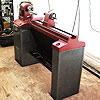John's post brings up the question to me is the brush on deft vs spray lacquer any different? Have never used either but hear tell the lacquer supposed to put " on " the shine. What kind of brush would one use to get the best finish, and how many coats to get there, sand in between with what grit and would one buff with or with out polish / caranuba or bees or say Minwax finish wax? phew that took for ever.....





 Reply With Quote
Reply With Quote









